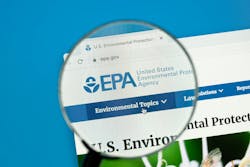EPA Recap: New PFAS Categories Added to Toxic Release Inventory, Perchlorate Regs for Drinking Water
The U.S. Environmental Protection Agency has proposed adding 15 per- and polyfluoroalkyl substances categories and 16 individual PFAS to the Toxics Release Inventory (TRI), a public database of toxic chemicals.
The proposed ruling, announced on Oct. 2, would impact more than 100 individual PFAS.
The ruling also would designate the substances as chemicals of special concern, so they must meet more stringent reporting requirements, including reporting for small concentrations.
The aim of the proposed rules is to help inform the public about sources of pollution in their communities and ways that facilities can eliminate or reduce such pollution, according to the EPA.
“With this rule, EPA would be able to collect data on how more than a hundred PFAS are released into the environment through Toxics Release Inventory reporting requirements,” said Assistant Administrator for the Office of Chemical Safety and Pollution Prevention Michal Freedhoff. “This information will help EPA and communities better understand how PFAS are being used and managed across the country.”
TRI requires regulated facilities to report annually to EPA the amount of these toxic chemicals released into the environment and managed through recycling, energy recovery and treatment. Facilities must also report on practices used to prevent or reduce the generation of these chemicals as waste. EPA makes the data publicly available to inform decision-making and support pollution prevention efforts.
The EPA has proposed limiting reporting requirements to 100 lbs. for manufacture, processing and other uses.
Perchlorate Standards Proposed
The EPA said Oct. 3 a review panel will seek input on new rules regulating perchlorate in drinking water.
Perchlorate is commonly used as an oxidizer in solid propellants, munitions, fireworks, airbag initiators for vehicles, matches and signal flares. It’s also used in some electroplating operations and found in some disinfectants and herbicides
The agency is developing a National Primary Drinking Water Regulation (NPDWR) for perchlorate under the authority of the Safe Drinking Water Act and as required by court orders. EPA has committed to issuing the NPDWR by November 2025 and a final regulation by May 2027.
